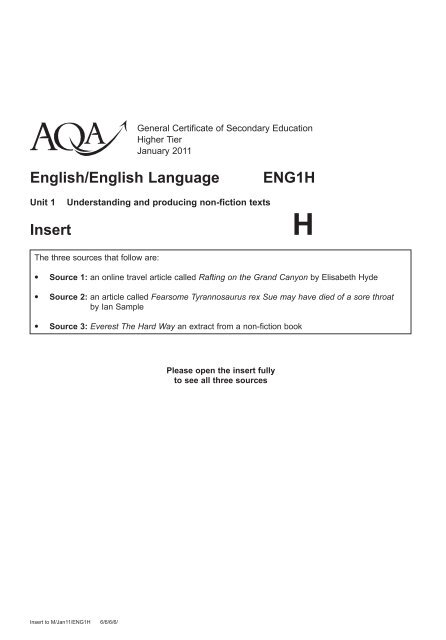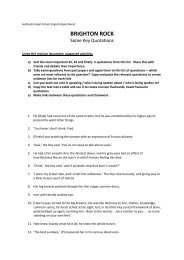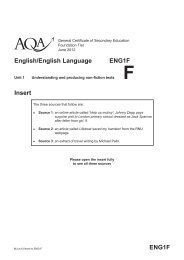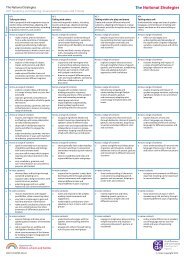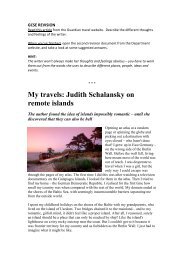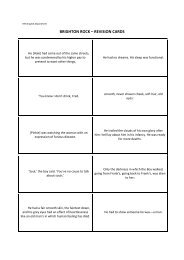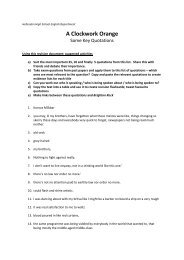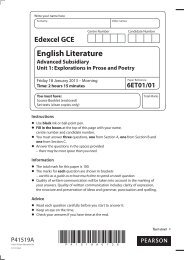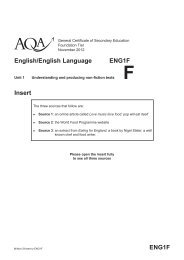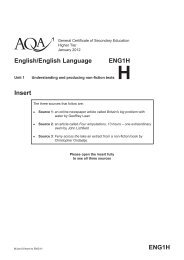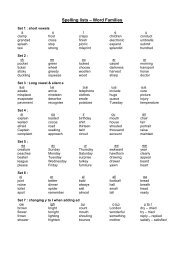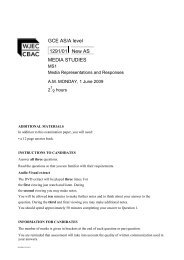English/English Language ENG1H Insert - Thomas Tallis School
English/English Language ENG1H Insert - Thomas Tallis School
English/English Language ENG1H Insert - Thomas Tallis School
You also want an ePaper? Increase the reach of your titles
YUMPU automatically turns print PDFs into web optimized ePapers that Google loves.
General Certificate of Secondary Education<br />
Higher Tier<br />
January 2011<br />
<strong>English</strong>/<strong>English</strong> <strong>Language</strong><br />
<strong>ENG1H</strong><br />
Unit 1<br />
Understanding and producing non-fiction texts<br />
<strong>Insert</strong><br />
H<br />
The three sources that follow are:<br />
• Source 1: an online travel article called Rafting on the Grand Canyon by Elisabeth Hyde<br />
• Source 2: an article called Fearsome Tyrannosaurus rex Sue may have died of a sore throat<br />
by Ian Sample<br />
• Source 3: Everest The Hard Way an extract from a non-fiction book<br />
Please open the insert fully<br />
to see all three sources<br />
<strong>Insert</strong> to M/Jan11/<strong>ENG1H</strong> 6/6/6/6/
2<br />
Source 1<br />
Rafting on the Grand Canyon<br />
by Elisabeth Hyde<br />
“Just two rules!” our guide Ed shouted. “Rule Number One – stay in the boat! Rule Number Two –<br />
stay in the boat!”<br />
It was early July, and we (me, my husband and our three teenage children) were in the middle of a<br />
13-day, 225-mile trip down the Colorado river through the Grand Canyon.<br />
On the first day, the 22 of us stood at the starting point, blinking at the sight before us: a long line<br />
of 6m rafts, masses of gear, an army of river guides scurrying about. This would be our world for<br />
the next two weeks.<br />
We were a mixed group: our fellow passengers ranged from our 13-year-old twin daughters to a<br />
couple in their mid-70s. You can’t be shy on a Grand Canyon river trip. Not when you’re spending<br />
two weeks with two dozen strangers, floating down one of the biggest rivers in North America.<br />
You’re on the water for five to eight hours every day, and when<br />
you’re off the water, you’re eating, sleeping, and bathing<br />
together in one of the most spectacular environments on earth.<br />
Our party filled five inflatable rafts, each rowed by a guide<br />
and four or six passengers. All the gear we could possibly<br />
need was strapped into these boats. It’s the tightest packing<br />
system I’ve ever seen, so that passengers ride perched on<br />
the side tubes – prime seats with great views.<br />
Rock, rocks, everywhere. During the calmer stretches our guides pointed out the various layers<br />
towering above us. Terracotta sandstone, flaky grey shale, massive maroon cliffs streaked with<br />
black – I kept straining my neck gazing up at the steep walls closing in on us.<br />
Riding the rapids in the Grand Canyon is a Disneyland-like experience – one second you’re<br />
plunging straight down into the trough of a wave, the next you’re getting drenched with cold spray<br />
as the boat shoots up and over the crest. It’s a white-knuckle, roller-coaster ride that has people<br />
screaming with the thrill of it.<br />
Which brings us back to Ed’s Rules. The only one who violated them during the trip was me. We<br />
hit one rapid at the wrong angle, and the boat rose up and pretty much ejected me into the foaming<br />
madness. For the next 45 seconds, I got sucked down and spun around and finally spat up into<br />
sunlight, gasping for air. Was I scared? A little. Exhilarated? More than I’ve ever been.<br />
By the time we rowed the last stretch, toward Diamond creek, our clothes and hair held about a<br />
pound of silt each, but nobody cared. I welcomed the chance for a shower, but the trip left me with<br />
a desire to run away and become a river guide.<br />
INSERT <strong>Insert</strong> to to M/Jan11/<strong>ENG1H</strong><br />
June 2010/3702/1H
3<br />
Source 2<br />
Fearsome Tyrannosaurus rex Sue may<br />
have died of a sore throat<br />
A parasite that infects pigeons made it increasingly difficult for the T. rex to swallow<br />
and led to starvation, a new study suggests.<br />
by Ian Sample<br />
Sue, the world’s largest Tyrannosaurus rex, may have been brought down by a humble parasite.<br />
The most famous specimen on<br />
public display was felled not in mortal<br />
combat, but by an infection that<br />
causes sore throats in pigeons.<br />
Nicknamed Sue, the seven-tonne<br />
T. rex at the Field Museum in<br />
Chicago (pictured right) is the largest<br />
and most complete example of the<br />
prehistoric predator ever unearthed.<br />
The fossil stretches 13 metres from<br />
nose to tail.<br />
The 65 million-year-old beast is<br />
known to have survived violent<br />
skirmishes that left her with<br />
three broken ribs, torn tendons<br />
and a damaged shoulder. But according to a study of Sue’s remains, her death was far more ordinary<br />
than her combat-scarred remains suggest.<br />
Researchers examined gouge marks in Sue’s jaw that were thought to have been inflicted in one-on-one<br />
battles with other tyrannosaurs.<br />
But closer inspection of the holes revealed striking similarities with indentations seen in modern birds<br />
that are caused by a common parasite that infects the mouth and throat.<br />
As the infection spread, Sue would have found it increasingly difficult to swallow and may eventually<br />
have starved to death, according to the research. The parasite, which today causes mild infections in<br />
pigeons, doves and other wild birds, probably spread by biting.<br />
<strong>Insert</strong> to M/Jan11/<strong>ENG1H</strong>
5<br />
There are no texts printed on this page<br />
Open out this page to see<br />
Source 2 and Source 3<br />
<strong>Insert</strong> to M/Jan11/<strong>ENG1H</strong>
4<br />
Source 3<br />
Everest The Hard Way<br />
Pete Boardman and Pertemba Sherpa have reached the summit of Everest and need to<br />
return to Camp 6 where their team member Martin Boysen is expecting their return. But their<br />
companion Mick Burke is still on the summit...<br />
A decision was needed. I pointed at my watch and said, ‘We’ll wait ten more minutes.’ Pertemba agreed.<br />
That helped us – it shifted some responsibility to the watch. I fumbled in my sack and pulled out our stove<br />
to leave behind. The time was up.<br />
At first we went the wrong way, too far towards the South Col*. There was a momentary lessening in<br />
the blizzard, and I looked up to see the rock of the South Summit. There was still no sign of Mick and<br />
it was now about half past four. The decision had been made and now we had to fight for our own lives<br />
and think downwards. The early afternoon had drifted into approaching night and our success was turning<br />
into tragedy.<br />
Pertemba is not used to moving without fixed ropes or in bad conditions. At first he was slow. Three<br />
times I virtually pulled him down in the sliding, blowing powdery snow. But he is strong and adaptable.<br />
He began to move faster and soon we were able to move together. Were we in the gully? I felt panic surge<br />
inside. Then I saw twin rocks in the snow that I recognized from the morning. We descended diagonally<br />
from there and in the dusk saw the oxygen cylinder that marked the top of the fixed rope over the rocks.<br />
We slid down to the end of the rope and tied a spare rope we had to it and descended the other hundred<br />
and fifty feet. From there we moved down and across for one thousand feet towards the last of the fixed<br />
ropes.<br />
But as soon as we started we were covered by a powder-snow avalanche from the summit slopes.<br />
Fortunately our oxygen cylinders were still functioning and we could breathe. We threaded our way<br />
blindly across the thin runnels of ice and snow that covered the sloping rocks. I felt a brush of snow on<br />
my head and looked up to see another big avalanche coming, channelled, straight at me. I looked across.<br />
Pertemba was crouched to hold my fall, and was whipping in the rope between us tight to my waist. I<br />
smashed my axe into the ice and hung on. The surging snow buffeted over and around me for minutes.<br />
Then it stopped. Pertemba had held; the axe had stayed in the ice.<br />
We moved on. It was a miracle that we found the last of the fixed ropes in the dark. On the fixed rope<br />
Pertemba slowed down and I pulled him mercilessly until he shouted that one of his crampons had fallen<br />
off. The rope between us snagged and, in flicking it free, I tumbled over a fifteen-foot rock.<br />
At half past seven we stumbled into Camp 6. Martin was there and I burst into tears.<br />
Pete Boardman<br />
* Col: a mountain pass<br />
<strong>Insert</strong> to M/Jan11/<strong>ENG1H</strong>
6<br />
There are no texts printed on this page<br />
ACKNOWLEDGEMENT OF COPYRIGHT-HOLDERS AND PUBLISHERS<br />
Permission to reproduce all copyright material has been applied for. In some cases, efforts to contact copyright-holders have been unsuccessful and AQA will be<br />
happy to rectify any omissions of acknowledgements in future papers if notified.<br />
Source 1: Adapted from El i s a b e t h Hy d e, Rafting on the Grand Canyon © Guardian News & Media 2010<br />
Source 2: Adapted from Ia n Sa m p l e, Fearsome Tyrannosaurus rex Sue may have died of a sore throat © Guardian News & Media 2009<br />
Photo: AFP/Getty Images<br />
Source 3: Adapted from Pe t e Bo a r d m a n in Everest The Hard Way by Chris Bonington (Hodder & Stoughton, 1976)<br />
<strong>Insert</strong> to M/Jan11/<strong>ENG1H</strong><br />
Copyright © 2011 AQA and its licensors. All rights reserved.


